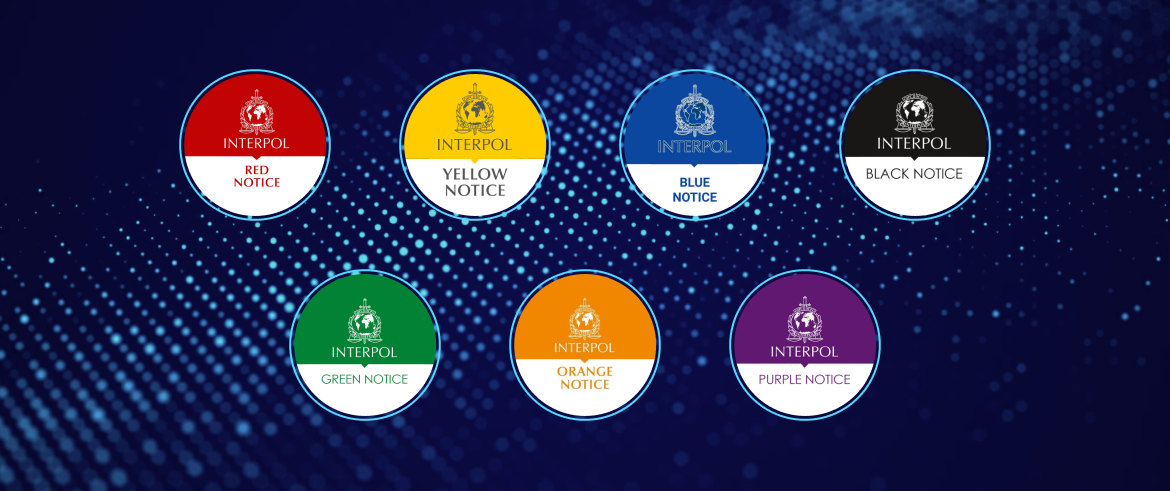
Interpol notices
INTERPOL Notices are international alerts allowing member nations’ law enforcement agencies to share crucial crime-related information.
These notices are issued by the General Secretariat at the request of a member country’s INTERPOL National Central Bureau and are accessible in the Interpol Notices database for all member nations to view.

Interpol color-coded Notices allow governments to share alerts and information requests globally.
Notices can also be issued at the request of International Criminal Tribunals and the International Criminal Court to find those sought for crimes committed under their authority, such as genocide, war crimes, and crimes against humanity. They can also be issued at the request of the United Nations in regard to the enforcement of Security Council sanctions.
| Notice Type | Color | Purpose |
|---|---|---|
| Red | Red | To seek the arrest or provisional arrest of wanted persons, with a view to extradition. |
| Blue | Blue | To locate, identify, or obtain information about individuals of interest in criminal investigations or to identify unidentified bodies. |
| Green | Green | To warn and provide information about individuals who have committed criminal offenses and are likely to repeat these crimes in other countries. |
| Yellow | Yellow | To locate and identify missing persons, especially minors or individuals unable to identify themselves. |
| Black | Black | To seek information about unidentified bodies. |
| Orange | Orange | To warn and provide information about potential threats from individuals, objects, or events that could harm public safety, security, or health. |
| Purple | Purple | To provide information about modus operandi, objects, devices, and concealment methods used by criminals. |
Most Notices are for police use only, but if the requesting nation decides to inform the public or seek their help, an excerpt may be posted on this site. All United Nations Special Notices are accessible to the public.
Watch this informative video to learn more about the different types of Interpol notices, including Red, Blue, and Green Notices, and how they impact individuals and international law enforcement.
Gain valuable insights on how these notices work and how our expert team can assist you with legal challenges related to Interpol alerts
Types of Interpol Notices

Interpol Notices are crucial for global law enforcement cooperation, serving various purposes. The Red Notice helps locate and apprehend international fugitives. Blue Notices gather information on individuals related to a crime, while Green Notices warn about criminal threats. Yellow Notices aid in finding missing persons, especially vulnerable ones, and Black Notices provide data on unidentified bodies. Orange Notices give general warnings about imminent threats, and Purple Notices centralize information on criminal methods and devices. These notices enhance international efforts to combat crime and promote a safer world.
Let’s recap:
- Red Notice: To locate and apprehend individuals wanted for prosecution or to fulfill a sentence.
- Yellow Notice: To assist in the location of missing persons, generally juveniles, or in the identification of those who are unable to identify themselves.
- Blue Notice: To gather further information regarding a person’s identity, whereabouts, or actions in connection with a criminal inquiry.
- Black Notice: To seek information about unidentified bodies, issue a black notice.
- Green Notice: To issue a warning about a person’s unlawful activity when the individual has been deemed a potential threat to public safety.
- Orange Notice: To alert the public to an event, a person, an item, or a process that poses a significant and urgent hazard to public safety.
- Purple Notice: To seek or offer information about criminals’ methods of operation, objects, gadgets, and concealing tactics.
- INTERPOL–United Nations Security Council Special Notice: Issued for organizations and persons who are the targets of UN Security Council Sanctions Committees.
Interpol Notices vs Diffusions
Interpol Diffusions are essential for global law enforcement and security, facilitating communication and collaboration among international police agencies. These alerts allow Interpol’s 194 member countries to quickly share information related to criminal investigations, including wanted persons, missing persons, assets, and threats. In the face of increasingly complex transnational criminal activities and threats to international peace, Interpol Diffusions play a crucial role. By pooling intelligence across borders, these alerts equip frontline officers with the information needed to proactively identify, track, and apprehend individuals of interest, enhancing global safety and security.
Wanted persons diffusions published per year
| 2017 | 2018 | 2019 | 2020 | 2021 |
|---|---|---|---|---|
| 16,048 | 15,763 | 15,697 | 13,618 | 12,940 |
New data reveals 1,000 Red Notices and Wanted Person diffusions rejected or deleted each year
INTERPOL has released new statistics on its Red Notices and Wanted Person diffusions. These statistics show that the agency rejects or deletes 1,000 of these notices annually. Nearly half of these rejections are due to human rights concerns or violations of INTERPOL’s neutrality. Fair Trials welcomes this transparency initiative, as they have long advocated for greater openness in INTERPOL’s operations.
Significant figures about Interpol Notices
- INTERPOL has rejected or deleted an average of 1,000 Red Notices and Wanted Person diffusions every year over the last five years.
- On human rights concerns, 150 Red Notices and Wanted Person diffusions were removed in 2021. Another 353 were removed because they were political, military, religious, or racial in nature.
- There are around 25,000 Red Notices and Wanted People distributions in circulation, with approximately 10,000 new Red Notices issued each year.






